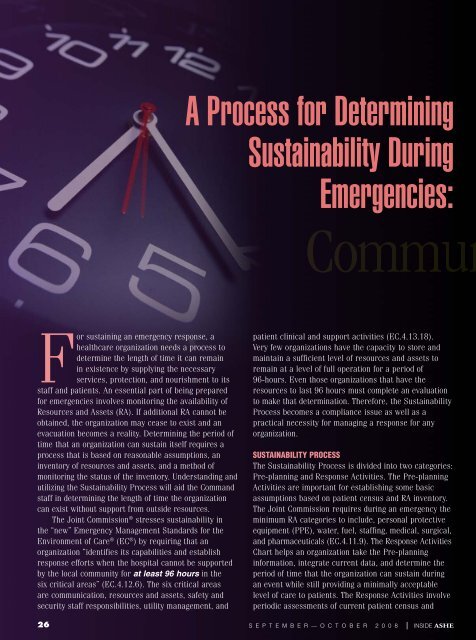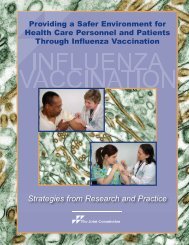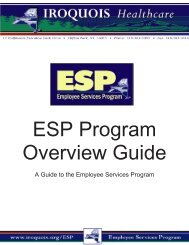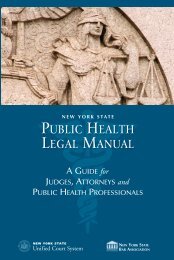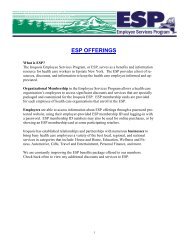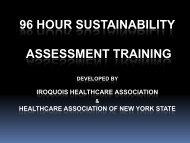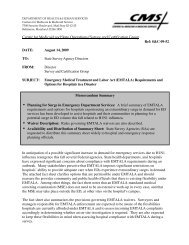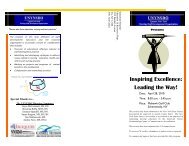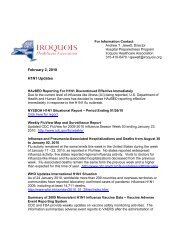Inside ASHE 96 Hour Rule
Inside ASHE 96 Hour Rule
Inside ASHE 96 Hour Rule
- No tags were found...
You also want an ePaper? Increase the reach of your titles
YUMPU automatically turns print PDFs into web optimized ePapers that Google loves.
A Process for DeterminingSustainability DuringEmergencies:For sustaining an emergency response, ahealthcare organization needs a process todetermine the length of time it can remainin existence by supplying the necessaryservices, protection, and nourishment to itsstaff and patients. An essential part of being preparedfor emergencies involves monitoring the availability ofResources and Assets (RA). If additional RA cannot beobtained, the organization may cease to exist and anevacuation becomes a reality. Determining the period oftime that an organization can sustain itself requires aprocess that is based on reasonable assumptions, aninventory of resources and assets, and a method ofmonitoring the status of the inventory. Understanding andutilizing the Sustainability Process will aid the Commandstaff in determining the length of time the organizationcan exist without support from outside resources.The Joint Commission ® stresses sustainability inthe “new” Emergency Management Standards for theEnvironment of Care ® (EC ® ) by requiring that anorganization “identifies its capabilities and establishresponse efforts when the hospital cannot be supportedby the local community for at least <strong>96</strong> hours in thesix critical areas” (EC.4.12.6). The six critical areasare communication, resources and assets, safety andsecurity staff responsibilities, utility management, andpatient clinical and support activities (EC.4.13.18).Very few organizations have the capacity to store andmaintain a sufficient level of resources and assets toremain at a level of full operation for a period of<strong>96</strong>-hours. Even those organizations that have theresources to last <strong>96</strong> hours must complete an evaluationto make that determination. Therefore, the SustainabilityProcess becomes a compliance issue as well as apractical necessity for managing a response for anyorganization.SUSTAINABILITY PROCESSThe Sustainability Process is divided into two categories:Pre-planning and Response Activities. The Pre-planningActivities are important for establishing some basicassumptions based on patient census and RA inventory.The Joint Commission requires during an emergency theminimum RA categories to include, personal protectiveequipment (PPE), water, fuel, staffing, medical, surgical,and pharmaceuticals (EC.4.11.9). The Response ActivitiesChart helps an organization take the Pre-planninginformation, integrate current data, and determine theperiod of time that the organization can sustain duringan event while still providing a minimally acceptablelevel of care to patients. The Response Activities involveperiodic assessments of current patient census and26 S E P T E M B E R — O C T O B E R 2 0 0 8 | INSIDE <strong>ASHE</strong>
Chart 1: Pre-Planning ActivitiesTHE INVENTORY OF RESOURCES & ASSETSConducting the inventory begins with a list of items thatwould be needed during an emergency. As stated earlier,The Joint Commission requires during an emergencythe minimum categories to include, PPE, water, fuel,staffing, medical, surgical, and pharmaceuticals.Identifying these items takes a significant effort from theentire organization. Developing a method for monitoringthe inventory is essential for all organizations. However,since the level of inventory fluctuates on a daily basis,an Actual Inventory should be conducted periodically foreach item to determine what could be available on anaverage day.28 S E P T E M B E R — O C T O B E R 2 0 0 8 | INSIDE <strong>ASHE</strong>
Chart 2: Census*The quantity of inventory consumed on a dailybasis, under normal conditions can be established fromordering records or purchase orders for a 12-monthperiod or any other methods that can be used to estimatethe quantity consumed. Items like potable water may beassessed through meter readings for the year, fuel forgenerators or boilers could be based on average runtimes or test period, and food for patients based onactual meals served. Estimating the consumption ofstaff, including licensed independent practitioners, issomewhat more difficult, but does require a method todetermine the number of staff available.Consumption Rate:Once the list of resources is developed for the inventory,the Annual Consumption of each item for a 12-monthperiod can be researched from ordering records, utilizationanalysis, or any other means. Knowing this quantity, abaseline Average Consumption Rate (items/day) can becalculated for the 12-month period. In calculating waterconsumption, for example, one east coast hospital,determined that 7,000,000 gallons of water was consumedduring the 12-month period of Jan-07 to Dec-07. It wasINSIDE <strong>ASHE</strong> | S E P T E M B E R — O C T O B E R 2 0 0 8further determined that most of the water consumptionwas from laundry, chillers and toilet usage, in that order.With this information, the hospital can develop proceduresfor consumption adjustment or curtailment of servicesduring a water shortage or outage. These procedureswould be developed during the Pre-Planning Activities.One exception is the consumption rate for fuel used bythe emergency power generators. The consumption ratefor these units, under operating conditions, will be thesame regardless of the census or number of individualsin the facility. The consumption rate can be calculatedfrom manufacturer’s specifications, the load testconducted monthly, or the four-hour load test requiredevery three years by The Joint Commission (EC.7.40.5)Sustainability:By knowing the Actual Inventory and the AverageConsumption Rate, the time to consume all of theRA available on an average day, or the InventorySustainability Period (hours), can be calculated. Oncethe Inventory Sustainability Period is determined, theSustainability Gap (the difference between the time theorganization can sustain on an Average Inventory and<strong>96</strong>‐hours) can be defined. All of these Pre‐Planningassumptions and calculations are based on the Census,which ties consumption to a measurable number. Is thisthe perfect number? No, but it provides the organizationwith an initial estimation to begin planning for anemergency.Decision Process:Identifying the Sustainability Period allows theorganization to make a number of decisions. Is itpractical to tie up funds to obtain more resources,assets, and storage capacity to maintain the normallevel of care throughout the <strong>96</strong>‐hour period? Might it bebetter to develop alternatives? These alternatives couldinclude consumption adjustments during the event inorder to sustain the organization’s longevity. ConsumptionAdjustment activities can be as simple as reducing the29
Sample Chart 3: Inventory & Sustainability Resources & Assets (RA)Chart 4: Response ActivitiesINSIDE <strong>ASHE</strong> | S E P T E M B E R — O C T O B E R 2 0 0 831


